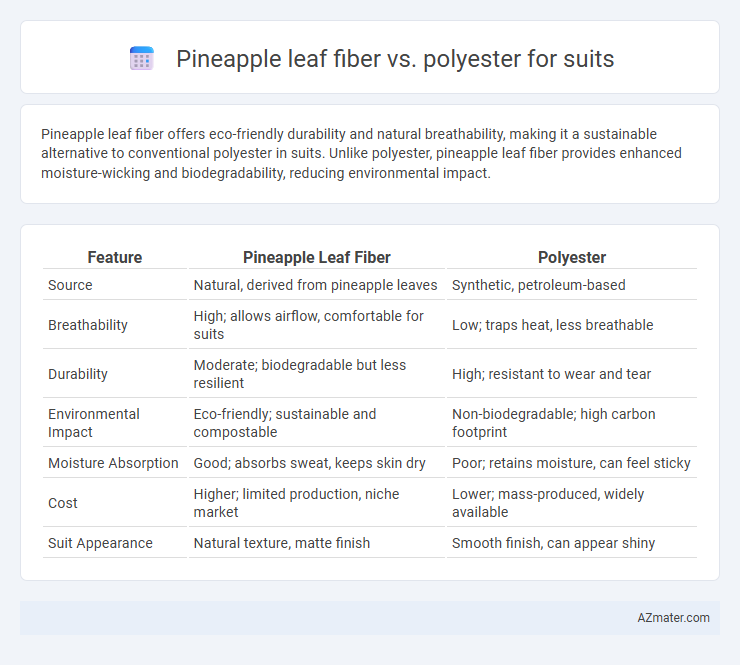Pineapple leaf fiber offers eco-friendly durability and natural breathability, making it a sustainable alternative to conventional polyester in suits. Unlike polyester, pineapple leaf fiber provides enhanced moisture-wicking and biodegradability, reducing environmental impact.
Table of Comparison
| Feature | Pineapple Leaf Fiber | Polyester |
|---|---|---|
| Source | Natural, derived from pineapple leaves | Synthetic, petroleum-based |
| Breathability | High; allows airflow, comfortable for suits | Low; traps heat, less breathable |
| Durability | Moderate; biodegradable but less resilient | High; resistant to wear and tear |
| Environmental Impact | Eco-friendly; sustainable and compostable | Non-biodegradable; high carbon footprint |
| Moisture Absorption | Good; absorbs sweat, keeps skin dry | Poor; retains moisture, can feel sticky |
| Cost | Higher; limited production, niche market | Lower; mass-produced, widely available |
| Suit Appearance | Natural texture, matte finish | Smooth finish, can appear shiny |
Introduction to Pineapple Leaf Fiber and Polyester
Pineapple leaf fiber, a sustainable and biodegradable natural fiber extracted from pineapple leaves, offers high tensile strength and breathability, making it an eco-friendly alternative for suit fabrics. Polyester, a synthetic fiber derived from petrochemicals, is widely used in suits for its durability, wrinkle resistance, and cost-effectiveness. Comparing pineapple leaf fiber to polyester reveals significant differences in environmental impact, texture, and moisture management properties.
Origin and Production Processes
Pineapple leaf fiber originates from the leaves of the pineapple plant, primarily harvested in the Philippines and other tropical regions, where the leaves are extracted after fruit harvesting without additional cultivation inputs. The production process involves decorticating the leaves to separate fibers, followed by washing, drying, and spinning into yarn, emphasizing eco-friendly and biodegradable qualities. In contrast, polyester is a synthetic fiber derived from petrochemicals through a complex chemical polymerization process involving purification, extrusion, and spinning, resulting in a durable but non-biodegradable fabric.
Environmental Impact Comparison
Pineapple leaf fiber, a biodegradable and renewable resource, significantly reduces environmental footprint compared to polyester, which is derived from non-renewable petroleum and contributes to microplastic pollution. The cultivation of pineapple leaves utilizes agricultural waste, minimizing land and water use, whereas polyester production involves high energy consumption and greenhouse gas emissions. Pineapple fiber suits offer a sustainable alternative by ensuring lower carbon emissions and facilitating natural decomposition at the end of their lifecycle.
Durability and Strength Analysis
Pineapple leaf fiber exhibits high tensile strength and excellent durability due to its natural lignin and cellulose content, making it resistant to wear and tear in suit fabrics. Polyester, a synthetic fiber, offers superior durability with high abrasion resistance and elasticity, ensuring long-lasting shape retention in suits. When comparing strength, polyester typically surpasses pineapple leaf fiber in tensile strength and resistance to environmental factors like moisture and UV exposure.
Comfort and Breathability Factors
Pineapple leaf fiber suits offer exceptional breathability and moisture-wicking properties, making them highly comfortable in warm climates compared to polyester, which tends to trap heat and reduce airflow. The natural fibers in pineapple leaf fabric allow better temperature regulation and skin ventilation, enhancing overall comfort during extended wear. In contrast, polyester suits often cause perspiration buildup and may feel less breathable, leading to discomfort in humid conditions.
Aesthetic Qualities and Suit Appearance
Pineapple leaf fiber offers a natural matte finish and subtle texture that enhances the sophistication and uniqueness of suits, providing an eco-friendly alternative with a handcrafted appeal. Polyester suits exhibit a smooth, consistent sheen that maintains sharp lines and resists wrinkles, giving a polished, modern look ideal for formal wear. The choice between pineapple leaf fiber and polyester significantly influences suit aesthetics, balancing organic texture against synthetic smoothness.
Cost and Market Availability
Pineapple leaf fiber offers an eco-friendly alternative to polyester with competitive costs influenced by its sustainable production from agricultural waste, yet its market availability remains limited and niche compared to the widely produced and globally accessible polyester fabric. Polyester suits generally incur lower manufacturing expenses due to mass production, established supply chains, and synthetic raw materials, making them more affordable and readily available in mainstream fashion markets. The emerging interest in sustainable textiles is gradually increasing the presence of pineapple leaf fiber suits, though polyester continues to dominate in cost-efficiency and market penetration.
Maintenance and Care Requirements
Pineapple leaf fiber suits require gentle hand washing or dry cleaning to maintain the fabric's natural texture and prevent damage, avoiding high heat that can cause brittleness. Polyester suits offer easy maintenance with machine washability and high durability, resisting wrinkles and shrinking, making them ideal for frequent use. Care for pineapple leaf fiber involves avoiding harsh chemicals and prolonged sun exposure, whereas polyester can withstand more aggressive cleaning agents and regular wear without loss of quality.
Sustainability and Eco-Friendliness
Pineapple leaf fiber offers a sustainable alternative to polyester for suits due to its biodegradable nature and low environmental impact during cultivation, requiring minimal water and no harmful pesticides. Unlike polyester, which is petroleum-based and non-biodegradable, pineapple leaf fiber reduces reliance on fossil fuels and mitigates microplastic pollution in ecosystems. Incorporating pineapple leaf fiber in suit production supports eco-friendly fashion by promoting renewable resources and reducing landfill waste.
Conclusion: Choosing the Better Suit Fabric
Pineapple leaf fiber offers exceptional sustainability and breathability, making it an eco-friendly choice for suits with natural moisture-wicking properties. Polyester suits excel in durability, wrinkle resistance, and affordability, but lack the environmental benefits and comfort of natural fibers. For a suit fabric that balances performance with ecological responsibility, pineapple leaf fiber is the superior option, especially for environmentally conscious consumers.

Infographic: Pineapple leaf fiber vs Polyester for Suit
 azmater.com
azmater.com